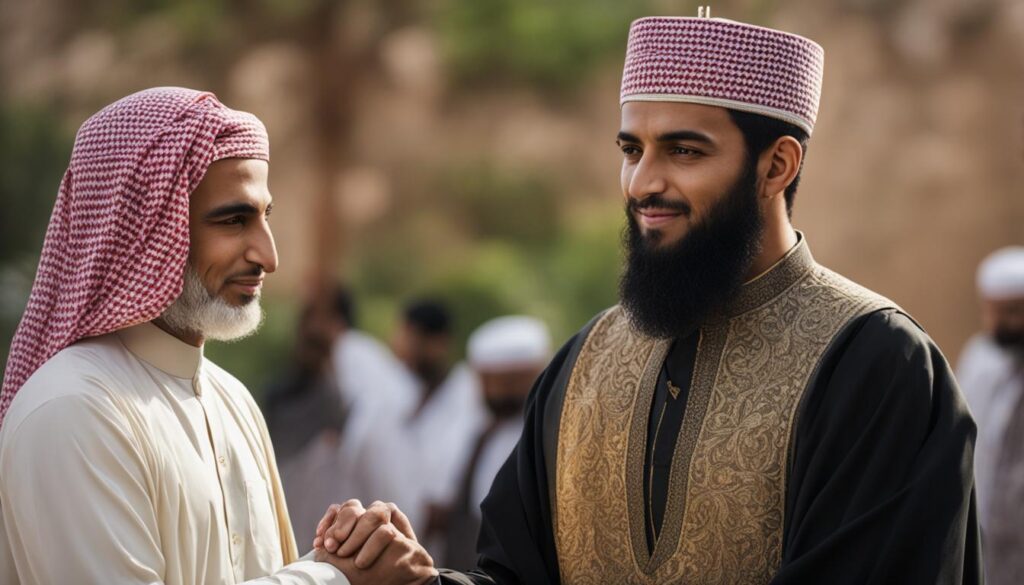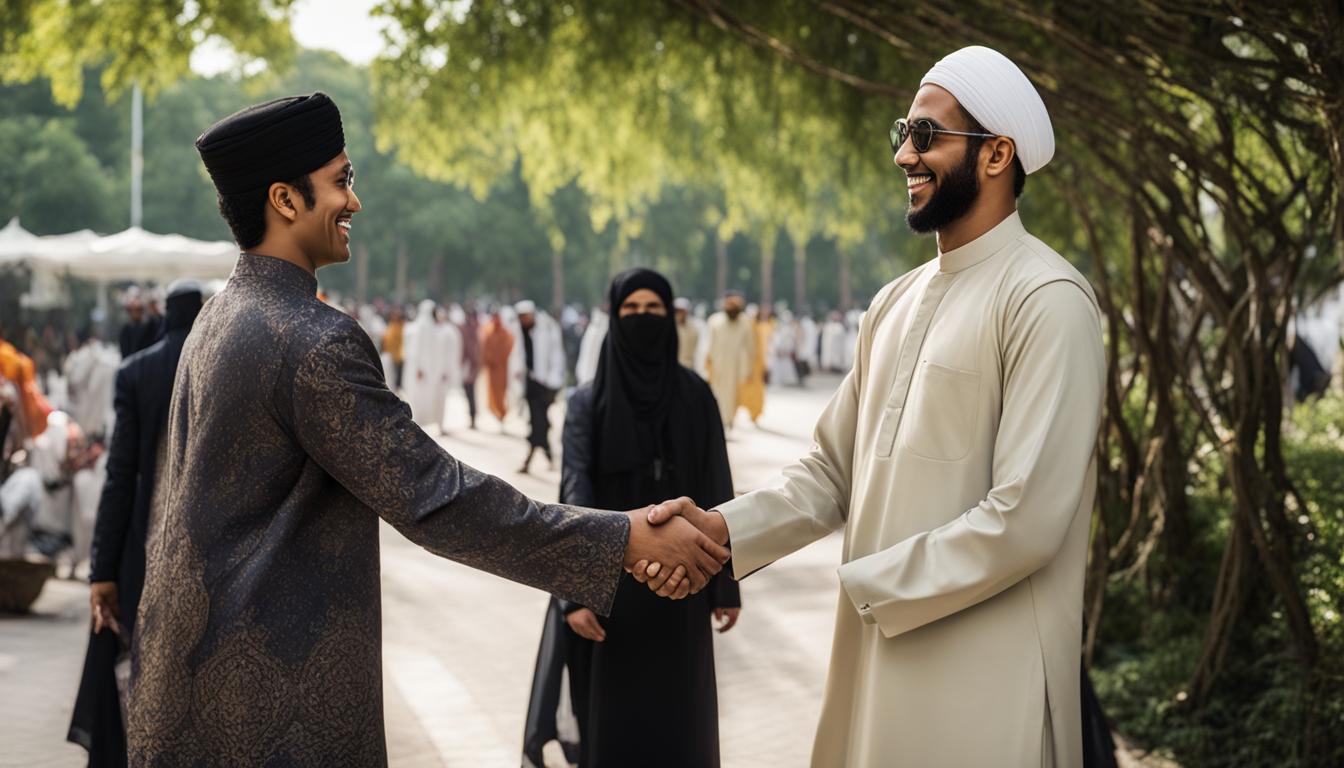The religion of Islam has rules of etiquette and a moral code involving every aspect of life. When greeting a Muslim man, it is important to be respectful and culturally sensitive. Understanding the customs and traditions associated with Islamic greetings is key to showing respect. In this article, we will explore effective and appropriate ways to greet a Muslim man.
Key Takeaways:
- Learn and use Islamic greetings, such as “As-salamu alaykum” and “Wa alaykum as-salam”.
- Respect personal preferences when it comes to physical contact and follow the individual’s lead.
- Be conscious of cultural customs and practices, avoiding offensive language and assumptions.
- Use non-verbal communication, such as eye contact and body language, to convey respect and friendliness.
- Show genuine interest, respect, and openness in your approach to create meaningful interactions.
Understanding Islamic Greetings
Islamic greetings play a significant role in Muslim culture, serving as a way to show respect and acknowledge one’s faith. The most common greeting among Muslims is “As-salamu alaykum,” which translates to “peace be upon you.” This greeting is used both verbally and in written form, and it reflects the desire for peace and blessings. It is customary to respond with “Wa alaykum as-salam,” meaning “and peace be upon you too.”
There are also other greetings commonly used, such as “Salam” and “Peace,” which carry similar sentiments of goodwill. These greetings should be used when interacting with Muslim men to ensure a respectful and culturally sensitive approach. By understanding and using these greetings appropriately, you can create a positive and meaningful interaction when greeting a Muslim man.
It is important to note that Islamic greetings are not exclusively reserved for Muslims. Non-Muslims can also use these greetings as a way to show respect and foster understanding among different cultures and faiths. Embracing the diversity of greetings used in Muslim culture promotes inclusivity and bridges the gap between communities.
Physical Greetings
When greeting a Muslim man, it is important to consider the cultural norms and personal preferences of the individual. Some Muslim men may prefer not to engage in physical contact, such as handshakes or hugs, with members of the opposite gender. In such cases, it is respectful to nod or give a slight bow as a greeting. If the Muslim man extends his hand for a handshake, it is appropriate to reciprocate. However, it is always best to wait for the Muslim man to initiate physical contact and follow his lead.
Understanding Boundaries
Muslim men may have varying levels of comfort when it comes to physical greetings. To greet them respectfully, it is important to observe their boundaries and preferences. Some Muslim men may be comfortable with handshakes, while others may prefer alternative forms of greeting, such as placing their hand on their heart or raising their right hand to their chest. By being observant and respectful of these boundaries, you can ensure a positive and respectful interaction.
Recognizing Gender Considerations
Understanding the cultural sensitivity around physical greetings is especially important when interacting with Muslim men. In some cases, there may be religious or cultural reasons why a Muslim man may choose not to engage in physical contact with a person of the opposite gender. By respecting these considerations and adapting your greeting accordingly, you can demonstrate your understanding and create a welcoming environment for all.
Physical greetings are an integral part of social interaction, and it is essential to approach them with cultural sensitivity and respect. By being mindful of the individual’s preferences, observing boundaries, and considering gender considerations, you can ensure that your greeting is respectful and well-received. Remember, a warm smile and a friendly demeanor go a long way in creating a positive connection when greeting a Muslim man.
Greeting a Muslim Man in a Culturally Sensitive Way
When it comes to greeting a Muslim man, it is important to do so in a culturally sensitive way. Understanding the etiquette and customs associated with Islamic greetings can help ensure that your greeting is respectful and appropriate. Verbal greetings are one aspect to consider, and using Islamic greetings like “As-salamu alaykum” or acknowledging the person’s faith in a respectful manner can be a great starting point.
However, it is equally important to be aware of non-verbal communication. Maintaining appropriate eye contact without staring excessively and using open and welcoming body language can convey friendliness and respect. It’s crucial to be mindful of personal space and avoid crossing your arms or standing too close, which may be perceived as invasive or disrespectful.
Etiquette for Greeting a Muslim Man
Etiquette plays a significant role in greeting a Muslim man respectfully. Each individual may have different preferences and levels of adherence to Islamic customs, so it is essential to respect their choices. Some Muslim men may prefer not to engage in physical contact with members of the opposite gender, while others may be more open to handshakes or hugs. To ensure you are being respectful, it is best to wait for the Muslim man to initiate physical contact and follow his lead.
Overall, the key to greeting a Muslim man in a culturally sensitive way is to show genuine interest, respect, and openness. By educating ourselves about Islamic customs and traditions, using appropriate verbal greetings, being mindful of non-verbal cues, and considering individual preferences, we can create meaningful and respectful interactions when greeting a Muslim man.

In conclusion, non-verbal communication is an essential aspect of greeting a Muslim man respectfully. Through maintaining appropriate eye contact, using open and welcoming body language, and being mindful of personal space, one can create a positive and respectful interaction with a Muslim man. By practicing these non-verbal cues, individuals can demonstrate genuine interest, respect, and cultural sensitivity when greeting a Muslim man.
Conclusion
Greeting a Muslim man respectfully requires understanding and practicing proper Islamic greetings, being sensitive to cultural customs, and being mindful of non-verbal communication. By taking the time to learn about Islamic customs and traditions, individuals can show genuine interest, respect, and openness in their approach to greeting a Muslim man.
One of the key aspects of Islamic greetings is using the appropriate phrases, such as “As-salamu alaykum” or “Peace be upon you.” These phrases not only convey respect but also show an understanding of Islamic culture. Additionally, being aware of the individual’s preferences regarding physical contact and following their lead is crucial in demonstrating respect.
Cultural sensitivity plays a vital role in greeting a Muslim man respectfully. Avoiding offensive language, assumptions, or stereotypes is important, as each individual may have different preferences and levels of adherence to Islamic customs. Taking the time to learn about their cultural background and asking questions in a respectful manner can deepen understanding and forge meaningful connections.
In non-verbal communication, maintaining appropriate eye contact, using open and welcoming body language, and being mindful of personal space are essential. This helps create a positive and respectful interaction when greeting a Muslim man.
Overall, the key to greeting a Muslim man respectfully lies in understanding and practicing Islamic greetings, being sensitive to cultural customs, and demonstrating respect through both words and actions. By doing so, individuals can foster meaningful and respectful interactions with Muslim men, fostering understanding and promoting inclusivity.
FAQ
What is the most common greeting used among Muslims?
The most common greeting among Muslims is “As-salamu alaykum,” which means “peace be upon you.”
How should I respond to the greeting “As-salamu alaykum”?
It is customary to respond with “Wa alaykum as-salam,” meaning “and peace be upon you too.”
What are other greetings commonly used when greeting a Muslim man?
Other greetings commonly used include “Salam” and “Peace.”
Should I initiate physical contact when greeting a Muslim man?
It is important to be respectful of personal preferences. Some Muslim men may prefer not to engage in physical contact with members of the opposite gender. It is best to wait for the Muslim man to initiate physical contact and follow his lead.
How can I greet a Muslim man verbally?
Using Islamic greetings, such as “As-salamu alaykum,” is a polite and appropriate way to start a conversation. Alternatively, one can use “Hello” or “Good morning/afternoon/evening” followed by a respectful acknowledgment of the person’s faith.
How can I show cultural sensitivity when greeting a Muslim man?
It is important to avoid offensive language, assumptions, or stereotyping. Each individual may have different preferences and levels of adherence to Islamic customs, so it is important to respect their choices and ask questions in a respectful manner.
What role does non-verbal communication play in greeting a Muslim man?
Non-verbal communication, such as eye contact and body language, plays a role in greeting a Muslim man respectfully. Maintain appropriate eye contact without staring excessively and use open and welcoming body language to convey friendliness and respect.
How can I create meaningful and respectful interactions when greeting a Muslim man?
By understanding and practicing proper Islamic greetings, being sensitive to cultural customs, and being mindful of non-verbal communication, you can create meaningful and respectful interactions when greeting a Muslim man.

